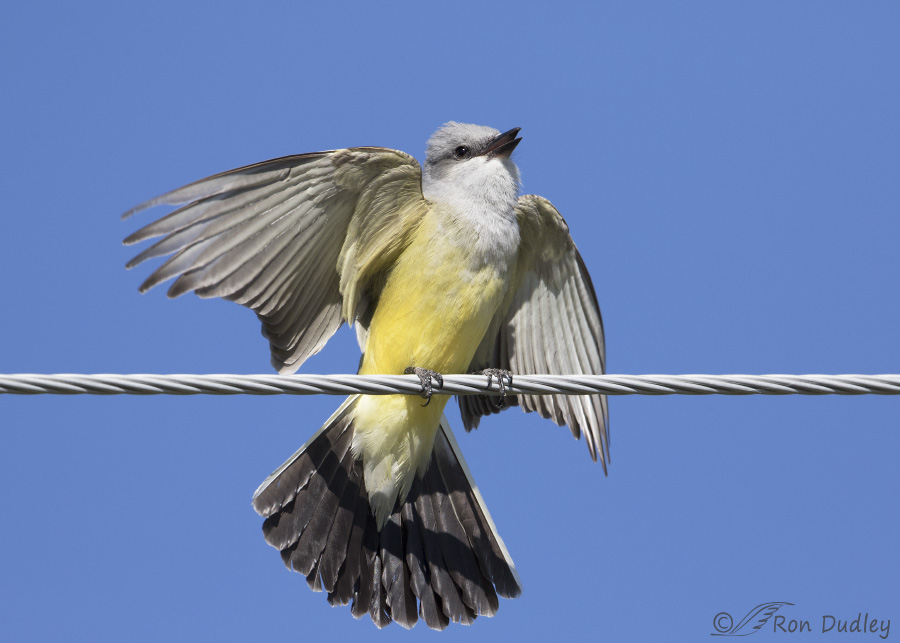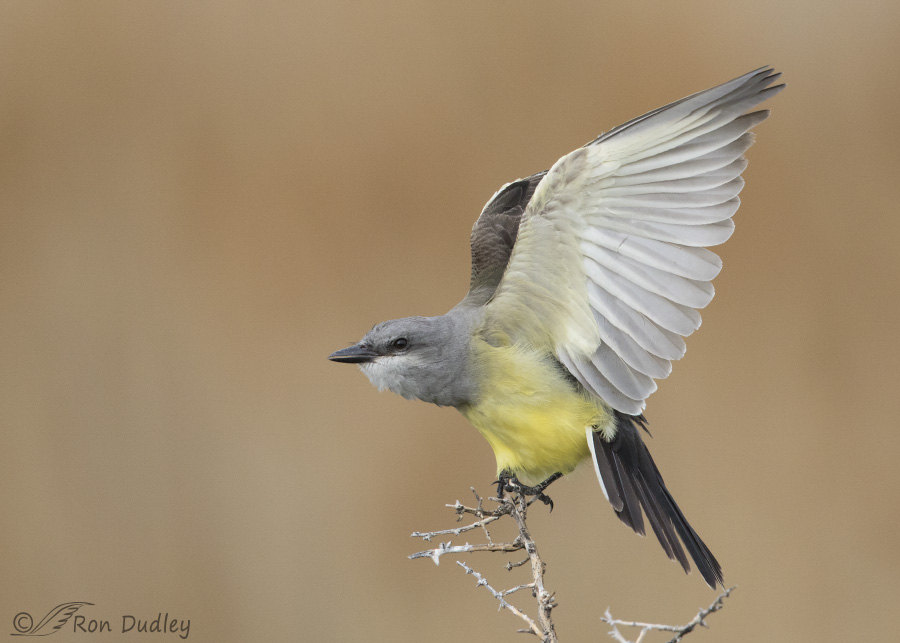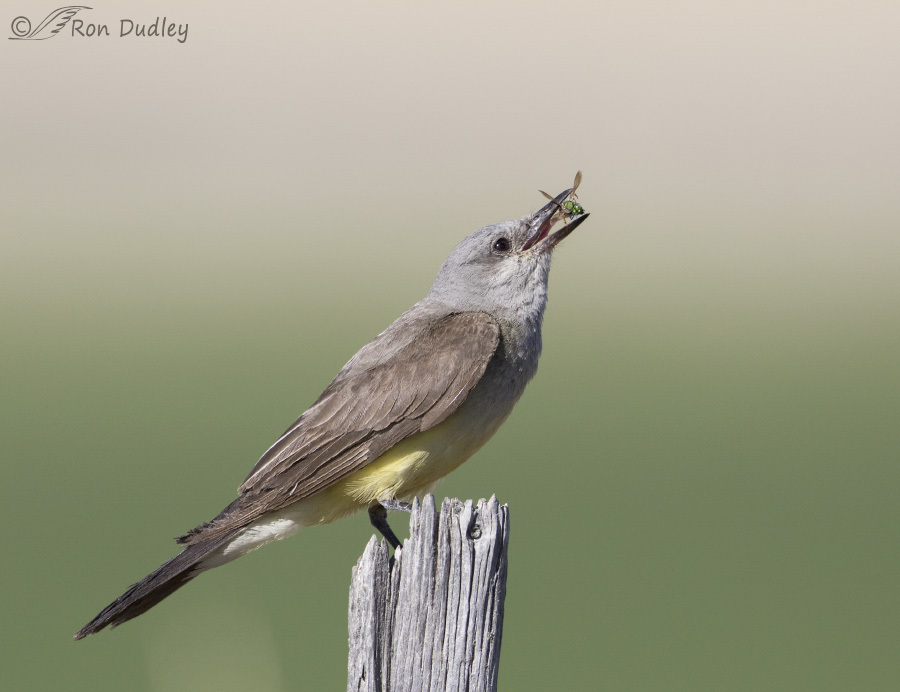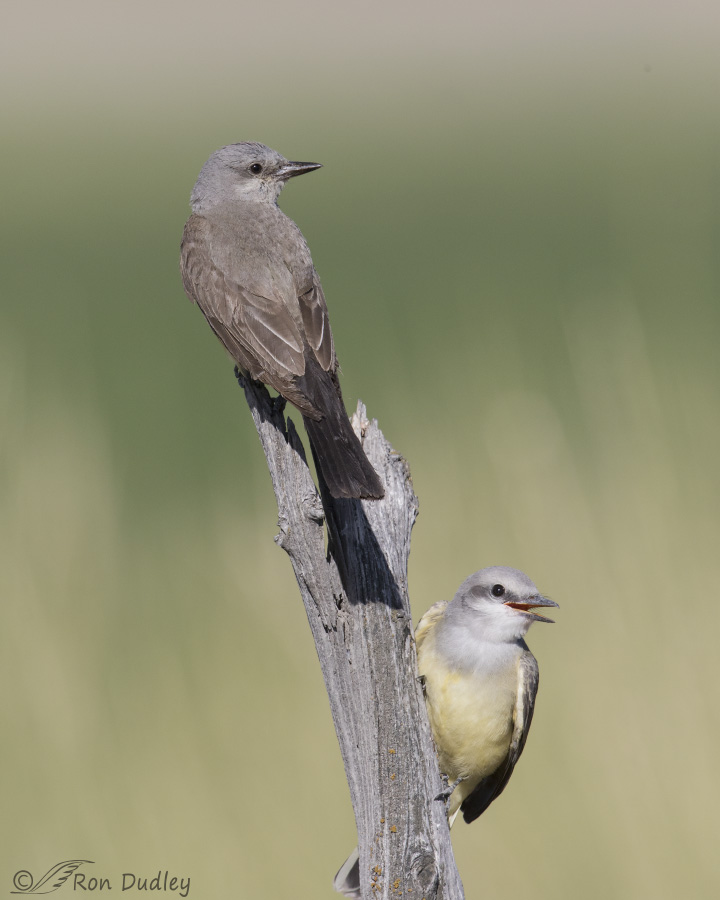One of the birds whose return I most look forward to in the spring is the Western Kingbird. I love their enthusiastic social displays and their exuberant chittering as they interact with each other. Their devotion to feeding hungry chicks after they’ve left the nest makes for some great photo ops as do their finely honed insect-hunting skills.
I’ve been seeing them in northern Utah for a couple of weeks now and I look forward to getting some shots of them I like very much but this year it hasn’t happened yet.
1/2500, f/6.3, ISO 500, Canon 7D Mark II, Canon EF 500mm f/4L IS II USM + EF 1.4 III Extender, not baited, set up or called in
This image from yesterday morning is as close as I’ve come. Readers know how much I dislike wires in my photos and I’m not happy with this composition but I really like the pose and the light and detail underneath the bird.
But the image inspires me to do better and it brings back memories of other kingbird behaviors I’ve photographed in the past such as the three photos below.
1/2000, f/6.3, ISO 1250, Canon 7D Mark II, Canon EF 500mm f/4L IS II USM + EF 1.4 III Extender, not baited, set up or called in
Most kingbird behaviors are quick and somewhat difficult to photograph well but this one gave me a slow but enthusiastic wing and tail stretch that allowed me to get quite a few similar (but still different) photos of the behavior. It’s a good thing the stretch was performed slowly in this low light situation that made me bump up my ISO into territory I seldom visit.
1/2500, f/7.1, ISO 500, Canon 7D Mark II, Canon EF 500mm f/4L IS II USM + EF 1.4 III Extender, not baited, set up or called in
I love photographing hunting kingbirds along old, rustic fence lines. They’re incredibly good hunters and typically they return to the rusty wire or a gnarly old fence post to gobble their prey down so interesting photo ops can be fairly easy to come by. This bird illustrates one of the reasons why kingbirds are classified as flycatchers.
1/2000, f/9, ISO 640, Canon 7D Mark II, Canon EF 500mm f/4L IS II USM + EF 1.4 III Extender, not baited, set up or called in
When kingbird chicks fledge and are still learning to fly they often follow their parents around (as best they can) and mob them for food. This adult at the top of the wooden post had just landed there after an unsuccessful attempt at an insect but the youngster at bottom still flew in and begged for a meal from its parent. I waited until I had eye contact from both birds and popped off a few shots. I had to shoot this image vertically for obvious reasons but even so I clipped the virtual tail of the chick. I was shooting at f/9 to give me just a little more depth of field.
Western Kingbirds are extremely aggressive in defending their territory (especially the area around their nest) from other birds and they often mob any raptor that might perch or fly nearby so one of my goals for this year is to photograph those behaviors. And to do it well.
Ron






Beautiful (specially #3)!! Thank you.
Thanks for these wonderful pictures, Ron!! The Kingbird is one of my favorites. For the past 3-4 years they have nested in our backyard, and watching them during the entire process is so fun!! Thus far, I haven’t seen any in Montana, but surely they will be here soon. You captured their beauty and spirit!
Jane, one of my first addicting experiences with photographing kingbirds was on our Montana farm some years ago. I had a blast even though I hadn’t yet developed the skills to photograph them particularly well.
Delightful pictures! I especially like the first one — even with the wire. The twist of the wire draws my eyes up to the bird’s face and wings and the colors are complementary.
I especially like the first one — even with the wire. The twist of the wire draws my eyes up to the bird’s face and wings and the colors are complementary.
Sorry I’m late to the show today. We had another vaccine clinic that was part of a big pet expo. At the booth next to us were some wildlife rehabbers with a GHO, a Barn Owl, and the biggest Red Tail I’ve ever seen — she was a beaut!!! I took some pictures with my phone, but they aren’t very good at all. They left fairly soon because there were so many dogs at our vaccine booth and the birds were getting nervous. I still can’t believe how gorgeous the RTH was. Sigh…
Marty, Can you believe that some folks take red-tails for granted (for lack of a better way to put it)? I know a very good bird photographer (who I like a lot) and he lives in southern California. He once said that red-tails are so common down there that he pretty much ignores them for his bird photography. I simply can’t imagine that, I really can’t…
She was absolutely spectacular and I got to be less than 10 feet from her!!!
Wonderful shots Ron. They are beautiful birds. Fun to watch too!
Thank you, Jean.
Gorgeous things. Feathered enchantment. Since I too get excited watching and waiting for birds half a world away perhaps I need to get a life. And I dp hope you get the shots you want (but doubt it, because your picky self is always looking for ways to improve). Which is simultanously good and bad.
EC, I think I’d be in a frenzy of excitement if I could see all or even some of the wonderful birds and other vertebrates you have in Australia. In my zoology and biology pursuits I’ve studied many of them in some detail of course but seeing them in the wild would be an entirely different ball game.
I hear you. There are some of our native animals I see often, some I see rarely and a few I have never seen. And would love to see. I am amazed by those I do see, and grateful for the privilege. And I still get excited waiting for ‘your’ birds to return.
Been there done that and I would go back in a heartbeat if I could. For a biologist it was like being a kid again either in a candy or toy store, whatever fits!
I’m saving up my pennies and hope to go once I’ve retired for good.
If there was a practical way to get there without flying I might consider going…
Flying is distincly unpleasant isn’t it? I do it if I have to, but never happily. I would really like to see you if you did get here though. And Marty K. Did you have a favourite species Dick? I would love to see Brolgas in the wild, and never ever see enough of either the echidna or the platypus. There are a kazillion birds I want to see too.
My wife and I went with Victor Emanuel Nature Tour, did the coast, flew to Darwin, than to the center back to the coast and then back to Sydney. Absolutely loved the three week trip! Had close to 470 species. Even though I’m a sucker for raptors I have to admit I was impressed with the Cockatoos, Corellas and Parrots. However the small Fairy-wrens were beautiful. We had a great time, just wish I had done this trip when I was younger so I could go back. We went in 2001 in September the year of the NY tragedy and the people were simply wonderful. I’ll always remember the support we were given.
The friendliness of the Aussies is legendary, even for someone like me who’s never been there. Mia’s been several times and often talks about their hospitality and genuine friendliness.
Love the shot with the fly. Well done! Hope you are able to get the shots you want this year.
Thank you, Susan. Welcome back!
Sensational series Ron !
Charlotte
Very nice photos. It is amazing you captured the red spot on the head. I did not know they had the spot until I had one in hand for rehab and was checking it over for injuries. I enjoy watching the fledglings too.
They don’t reveal that red crown patch very often, April. I see it most often when they’re displaying aggressively toward other birds but even then it’s hard to see, partly because it only lasts for a very short time.
Hi Ron,
Great post as usual and love the images. I had a ball with these guys down in Borrego Springs this last winter, especially when they were perching on blooming Ocotillos. I did have the opportunity with one preening bird to catch the ruby crown that you don’t often get to see. Its interesting to note that National Geographic western field guide does not describe the crown. I have not looked at Peterson’s. The crown is so concealed that I am curious as to its genetic purpose and I am assuming it’s present on the males only (could be wrong). I am not a female Western Kingbird so I am sure there is something I am missing.
Thanks again for your blog efforts. They are an integral part of my morning routine.
Thank you, Frank. Actually both sexes have the red crown patch though it isn’t often seen in either one.
https://www.featheredphotography.com/blog/2014/08/21/the-seldom-seen-red-crown-patch-of-the-western-kingbird/
https://www.featheredphotography.com/blog/2012/07/08/at-long-last-the-red-crown-patch-of-the-western-kingbird/
Beautiful shots, Ron! We mainly see them on the power lines in the yard hunting and doing “guard duty”. We also have the Eastern King Birds tho they are more on the fences outside the yard. They aren’t here yet.
We mainly see them on the power lines in the yard hunting and doing “guard duty”. We also have the Eastern King Birds tho they are more on the fences outside the yard. They aren’t here yet. 
Thank you, Judy.
Wonderful shots Ron. I especially like the first and third images. Great shot of the trapped insect in the bill.
Waiting impatiently for our Eastern Kingbird to show up. However, we have had cool, dank, cloudy, rainy weather and even the Tree Swallows are having trouble finding food.
Thanks, Dick. Good luck with your Easterns. And your weather.
Love the photos and those birds! Our Eastern Kingbirds have now arrived back here again too. I enjoy seeing them and have even managed to take a few “p-poor” shots of my own. Did you use a tripod for these pictures or are you shooting from your truck?
Joanne, We have Eastern Kingbirds too but not nearly so many of them as the Westerns. I shot all of these photos from my pickup.